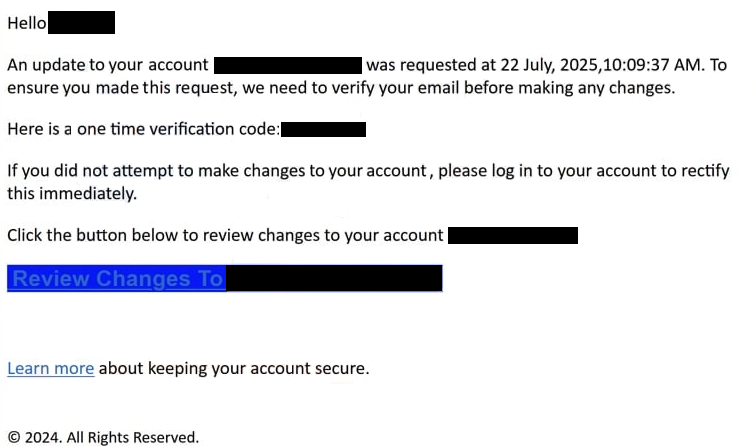Remove “Update To Your Account Was Requested” email
The “Update To Your Account Was Requested” email is a phishing attempt that targets email login credentials. The email is disguised as a notification from a service provider, supposedly informing you that an update to your account was requested, and to ensure that you were the one who initiated it, you need to verify your email. The email includes a button to supposedly verify the email, but it will lead to a phishing site. If you enter your email login credentials on this phishing site, they will be stolen by the malicious actors operating this phishing campaign. This could lead to your email account being hijacked.
The “Update To Your Account Was Requested” email is fairly generic and more or less obvious. It claims that for security reasons, an initiated change to your account needs to be confirmed. The email even includes a one-time verification code to make it seem more credible. The email includes a “Review Changes to [your email username]” button that will supposedly allow you to confirm the changes and verify the account.
The button directs you to a phishing site designed to steal your email login credentials. Although the site may not appear highly convincing, it can deceive inattentive users. If login information is entered on this phishing site, the details are sent to cybercriminals, granting them access to your email account if no additional security measures (e.g., two-factor authentication) are in place.
It is crucial for you to exercise caution with your login credentials, especially email credentials, as they are highly valuable to hackers. Email accounts often contain a lot of sensitive personal information and are frequently linked to other accounts. Unauthorized access to an email account can compromise these linked accounts as well. If you fall victim to such a phishing attempt, immediately change your passwords if you can still access your account. If access is lost and recovery options fail, disconnect the compromised email from associated accounts to prevent further unauthorized access.
The full “Update To Your Account Was Requested” phishing email is below:
Subject: Email Notification
Hello -,
An update to your account – was requested at 22 July, 2025,10:09:37 AM. To ensure you made this request, we need to verify your email before making any changes.
Here is a one time verification code: –
If you did not attempt to make changes to your account, please log in to your account to rectify this immediately.
Click the button below to review changes to your account –
Review Changes To –
Learn more about keeping your account secure.
© 2024. All Rights Reserved.
Signs of a phishing email
The “Update To Your Account Was Requested” email is clearly a phishing attempt. Legitimate service providers do not send such emails, so the contents do not make much sense. Because this is a generic phishing attempt, it’s relatively easy to identify as such. A lot of phishing campaigns use generic emails targeting hundreds, if not thousands, of users simultaneously, so they’re rather easy to identify. More advanced phishing emails, however, are often tailored to specific people or organizations, making them significantly harder to detect. These personalized emails can appear highly convincing and may deceive even cautious users under the right circumstances. Thankfully, most users are not the intended targets of such sophisticated attacks. By understanding common phishing indicators, users can frequently recognize these emails with little difficulty.
When receiving an unsolicited email asking you to click a link or download an attachment, you need to verify the sender’s email address before anything else. Generic phishing emails are often sent from email addresses whose domain does not match your email provider. Some malicious email addresses look completely random, so it’s immediately obvious they’re not legitimate. However, we should mention that some attackers take extra steps to make their email addresses look legitimate, using methods like substituting letters (e.g., using “rn” instead of “m”) or adding characters to mimic trusted senders. Researching the sender’s email address with a search engine can help confirm whether it matches the address that belongs to whomever the sender claims to be.
Finally, phishing emails often have spelling and grammar mistakes, which are obvious additional signs of a malicious email. The “Update To Your Account Was Requested” email is also written awkwardly and unprofessionally. Furthermore, pay attention to how you are addressed in the email. The email uses your email username to address you, and that’s another giveaway because you would be addressed by name if the email were legitimate.
Site Disclaimer
WiperSoft.com is not sponsored, affiliated, linked to or owned by malware developers or distributors that are referred to in this article. The article does NOT endorse or promote malicious programs. The intention behind it is to present useful information that will help users to detect and eliminate malware from their computer by using WiperSoft and/or the manual removal guide.
The article should only be used for educational purposes. If you follow the instructions provided in the article, you agree to be bound by this disclaimer. We do not guarantee that the article will aid you in completely removing the malware from your PC. Malicious programs are constantly developing, which is why it is not always easy or possible to clean the computer by using only the manual removal guide.

